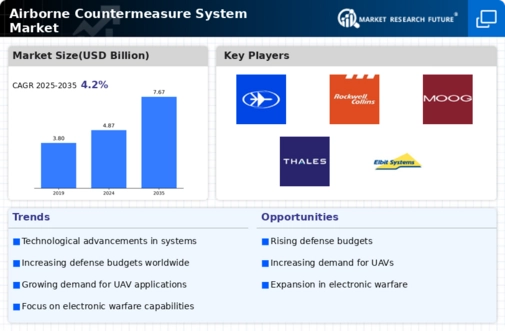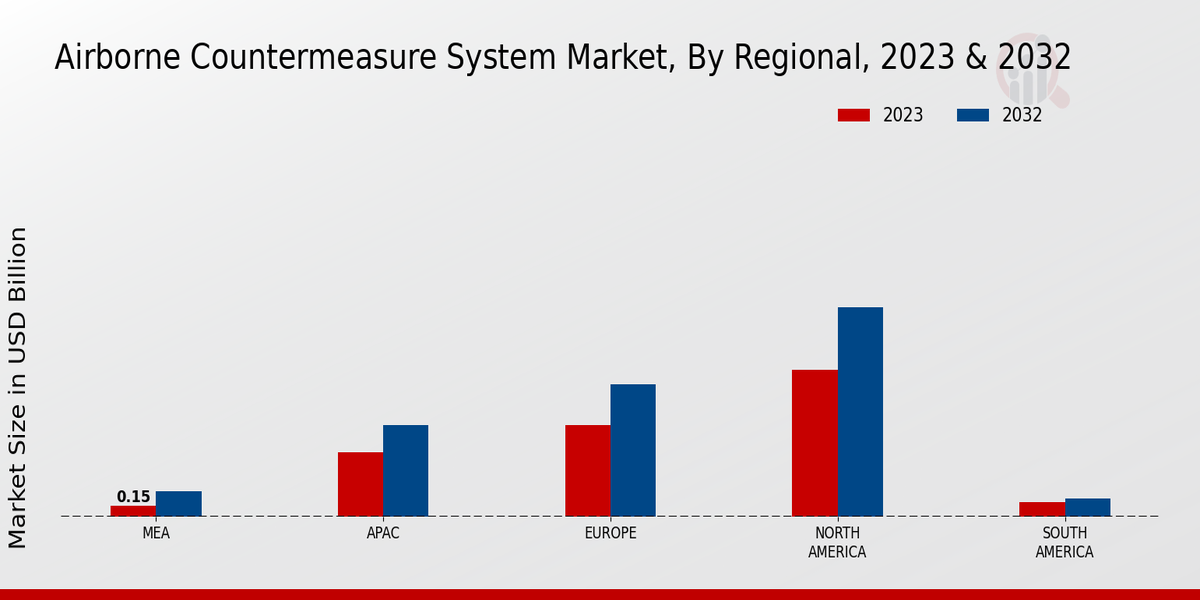Geopolitical Tensions
Geopolitical tensions are a significant driver of the Global Airborne Countermeasure System Market Industry. Ongoing conflicts and territorial disputes compel nations to enhance their defense postures. For instance, tensions in Eastern Europe and the Asia-Pacific region have led to increased military readiness and investment in airborne countermeasures. Countries are focusing on developing and acquiring advanced systems to counter potential threats from adversaries. This strategic emphasis on defense capabilities is likely to sustain market growth, with projections indicating a market value of 7.67 USD Billion by 2035, as nations prioritize the protection of their airspace.
Increasing Defense Budgets
The Global Airborne Countermeasure System Market Industry is experiencing growth driven by rising defense budgets across various nations. Countries are allocating more resources to enhance their military capabilities, particularly in response to evolving threats. For instance, the United States has proposed a defense budget of 886 billion USD for 2024, which includes significant investments in advanced airborne systems. This trend is mirrored in other regions, as nations prioritize modernization and technological advancements in their defense strategies. As a result, the market is projected to reach 4.87 USD Billion in 2024, reflecting a robust demand for sophisticated airborne countermeasure solutions.
Technological Advancements
Rapid technological advancements are propelling the Global Airborne Countermeasure System Market Industry forward. Innovations in electronic warfare, radar systems, and countermeasure technologies are enhancing the effectiveness of airborne systems. For example, the integration of artificial intelligence and machine learning into countermeasure systems allows for real-time threat assessment and response. These advancements not only improve operational efficiency but also increase the survivability of aircraft in contested environments. As nations seek to leverage cutting-edge technologies, the market is expected to grow at a CAGR of 4.21% from 2025 to 2035, indicating a sustained interest in modernizing airborne countermeasure capabilities.
Market Trends and Projections
Emerging Markets and Regional Developments
Emerging markets are playing a pivotal role in shaping the Global Airborne Countermeasure System Market Industry. Countries in Asia, the Middle East, and Africa are enhancing their defense capabilities, driven by regional security concerns and economic growth. For instance, nations like India and Saudi Arabia are investing heavily in modernizing their military forces, which includes acquiring advanced airborne countermeasure systems. This regional focus on defense modernization is expected to contribute to the overall market expansion, as these countries seek to bolster their air defense capabilities in response to evolving threats.
Growing Demand for Unmanned Aerial Vehicles
The proliferation of unmanned aerial vehicles (UAVs) is influencing the Global Airborne Countermeasure System Market Industry. As UAVs become integral to military operations, the need for effective countermeasures against these platforms is rising. Nations are investing in systems that can detect, track, and neutralize UAV threats. For example, the development of advanced jamming and spoofing technologies is gaining traction to counteract UAV capabilities. This trend is expected to drive market growth, as the increasing deployment of UAVs necessitates robust airborne countermeasure solutions to ensure air superiority and operational effectiveness.
















